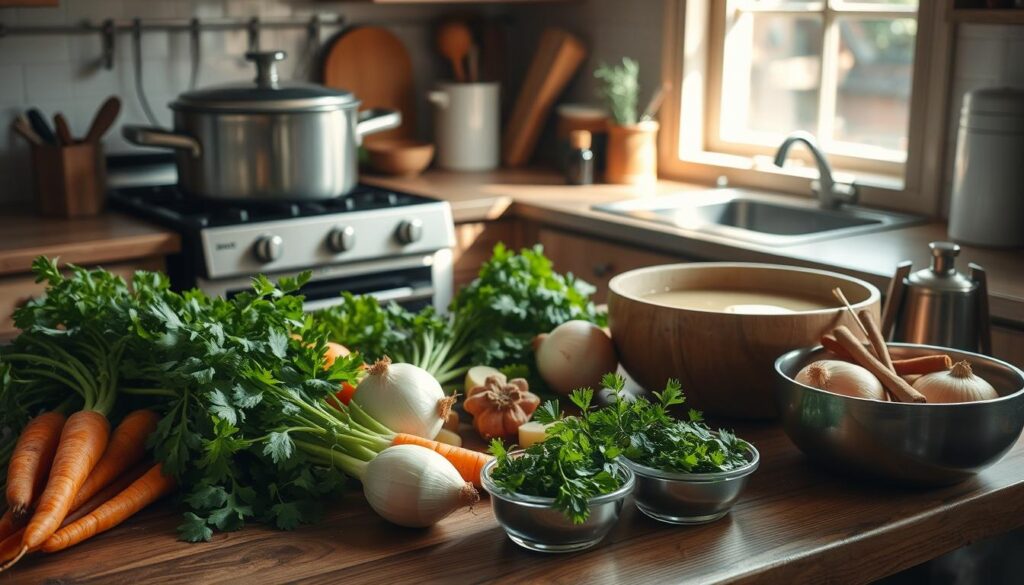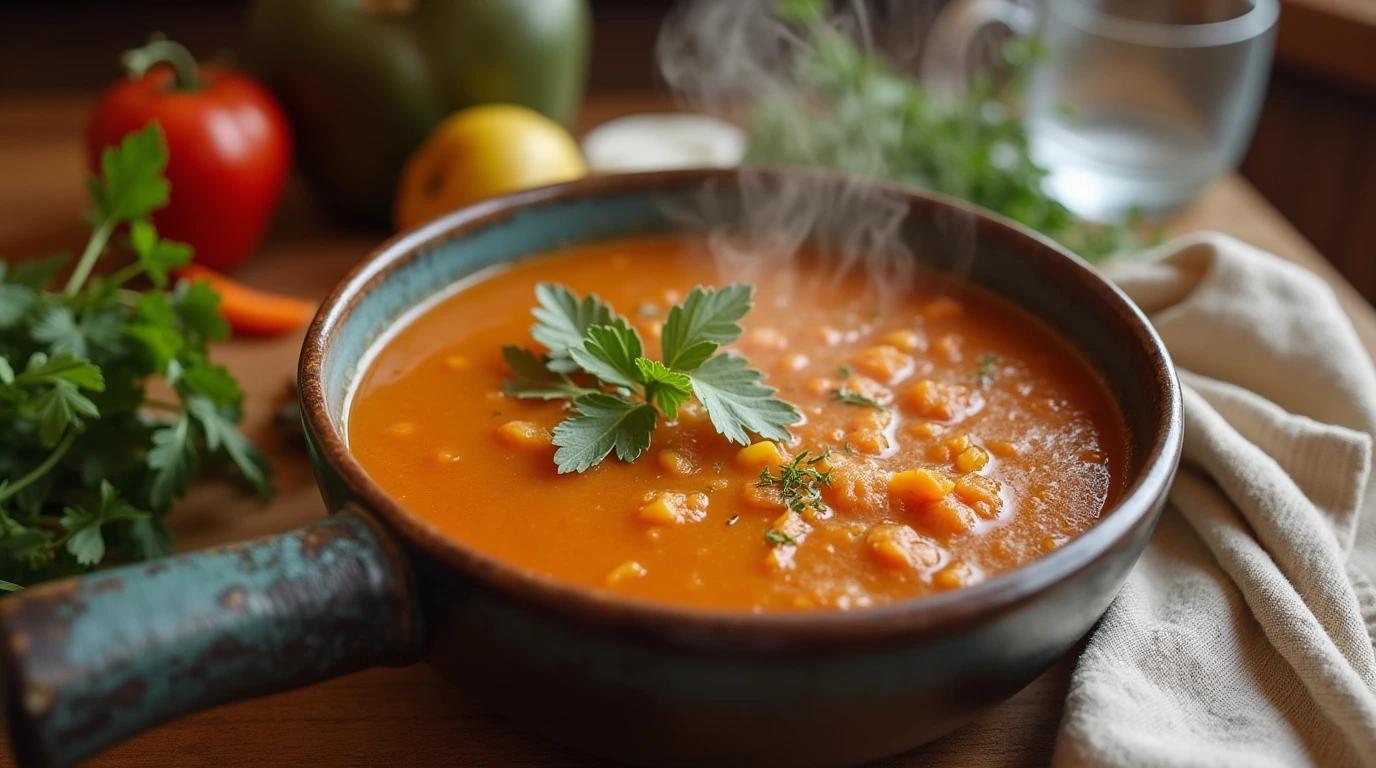Making the perfect bowl of soup is a journey filled with comfort and nostalgia. It’s like getting a warm hug. What Is the Secret Ingredient in Soup? It’s not just about the ingredients themselves but the techniques and care that bring them together beautifully, transforming simple components into a harmonious, soul-warming dish.
A good soup starts with a tasty liquid base. Then, you add aromatic elements, wholesome fats, and the right ingredients. This mix turns a simple dish into a masterpiece. Let’s dive into the basics of making an amazing soup, and you’ll become a pro in no time.

The Foundation: Understanding the Basics of Soup
Making a tasty soup starts with knowing the basics. Soup has three key parts: liquid base, aromatics, and fats. These elements are the soup’s foundation, adding depth and harmony to the dish.
The liquid is the soup’s base, providing moisture. Homemade stock is better than bouillon cubes for flavor. Chicken stock cooks in about an hour, while lamb takes two hours. Beef stock can take even longer.
Aromatics like onions, carrots, and garlic are crucial for flavor. Fresh herbs and spices like basil, thyme, and cumin add vitality. Salt and pepper balance the taste, making it sharp.
Letting the soup rest for 30 minutes to an hour helps the flavors blend. Surprisingly, soup tastes better the next day. Garnishes like croutons or grated cheese make the dish look and taste great.

Broth vs. Stock: What Is the Secret Ingredient in Soup?
Knowing the difference between broth and stock is key for anyone who loves to cook soups. These two ingredients play different roles in soup making. Broth is lighter, made by simmering meat and veggies in water. Stock, on the other hand, is made from bones and is more robust, giving soups a deep flavor.
Defining Broth and Stock
Broth is cooked for a shorter time, making it light and clear. It’s perfect for a simple, comforting soup. Stock, though, needs longer cooking, sometimes up to 24 hours for brown stocks. This longer cooking time makes the stock thick and flavorful.
Fumet, used in seafood stocks, is cooked for 1 to 2 hours. It adds a special taste to fish soups without browning.
Choosing the Right Base for Your Soup
When picking a soup base, think about the flavor you want. Stock adds richness from bones, great for hearty soups. Broth is better for lighter, fresher soups.
For example, a vegetable broth is refreshing, while beef stock makes soups richer. Store-bought bouillon can be convenient but has high sodium. Homemade is healthier but takes more time.
Both stock and broth recipes use common ingredients like onions, carrots, and herbs. These ingredients add basic tastes that make any soup better.
The Power of Aromatics in Soup Making
Aromatics like onions, garlic, carrots, and leeks are key to making soups flavorful. When sautéed, they release oils that add depth to the soup. This initial step is crucial for a soup’s flavor.
Essential Aromatics for Flavor Enhancement
The right aromatics can make or break a soup. Mixes like sofrito, mirepoix, and the Cajun trinity add unique flavors. Using fresh ingredients is important for the best taste.
Onions, garlic, and celery are staples for rich soups. They form the base of the flavor.
The Process of Sweating Aromatics
Sweating aromatics is a key technique in soup making. It involves cooking them gently in fat to release their flavors. This method makes the soup taste richer.
Simmering vegetables in a covered pot also enhances flavors. It steams them in their own juices, creating complex tastes.
The balance of flavors from sweating aromatics makes a dish satisfying. Browning ingredients before simmering adds savory notes. These practices make the broth more flavorful and the dish more enjoyable.
| Aromatic | Flavor Profile | Common Uses |
|---|---|---|
| Onion | Sweet, pungent | Base for soups and stews |
| Garlic | Strong, savory | Enhancing umami, marinades |
| Carrot | Sweet, earthy | Adding sweetness to balance flavors |
| Leek | Mild, sweet | Substituting for onions, soups |
| Celery | Herbaceous, slightly bitter | Flavor base in mirepoix |
Fat: The Unsung Hero of Flavor
Fats are key in soup making, adding flavor and richness. Using fats like olive oil, butter, or heavy cream brings out the taste. This makes the soup more enjoyable to eat.
Fat improves the soup’s texture and releases flavors from ingredients. This flavor enhancement in soup makes the broth more satisfying. It’s important to balance fats and liquids for the best taste.
Chefs say fats are crucial for a balanced soup. Mixing fats with herbs or umami boosters adds depth. Choosing the right types of cooking fat is as important as picking other ingredients. It enhances the soup’s flavor.
Ingredient Alchemy: Selecting the Right Components
Making a tasty soup starts with picking the right ingredients. It’s about finding the perfect mix of vegetables and proteins. This balance brings out the best flavors and textures, meeting everyone’s tastes and dietary needs.
Vegetable Selection for Optimal Flavor
Choosing the right vegetables is key to a great soup. Fresh, tasty veggies add sweetness and depth. Pick sturdy veggies like potatoes or carrots for texture. Add mushrooms and leafy greens for extra flavor.
Roasting veggies before adding them makes them sweeter and more complex. This simple step can turn a basic soup into a memorable dish.
Protein Power: Enhancing Your Soup
Adding protein makes your soup richer and more satisfying. You can choose from meaty options or go for vegetarian protein. Beans and lentils are great for a plant-based choice.
When you add protein, timing is everything. Tofu, for example, soaks up flavors well if added early. This ensures all ingredients blend together beautifully.
| Protein Type | Flavor Impact | Cooking Time Consideration |
|---|---|---|
| Raw Chicken | Rich, savory | 20-30 minutes |
| Seafood | Light, fresh | 5-10 minutes |
| Beans | Earthy, hearty | 15-20 minutes (cooked) |
| Lentils | Nutty, balanced | 20-30 minutes (dried) |
| Tofu | Subtle, absorptive | 15-20 minutes |
By mixing the right veggies and proteins, your soup will be full of life and taste. It will please everyone and offer a healthy, enjoyable meal.
Grains, Noodles, and Starches: Adding Comfort to Your Soup
Grains and starches make soups more than just a meal. They turn them into hearty comfort food. Ingredients like barley, rice, or whole grain pasta add texture and make the dish more satisfying.
When you add grains to your soup, they soak up the flavors. They also add their own taste. It’s important to know when to add them. Grains can simmer with the soup, but noodles should be added later to keep them firm.
Choosing the right grain or starch can make your soup better. Barley gives a chewy texture, while rice adds a comforting base. Pasta comes in many shapes, each adding its own twist.
Trying different grains and noodles not only adds nutrients but also makes the meal more enjoyable. Adding them to your soup brings a sense of satisfaction. It makes the soup a true comfort food for any time.
Techniques for Soup Success: Mastering Preparation Methods
Learning how to prepare soup can really improve your cooking. Techniques like sautéing, roasting, and browning are key. They help turn a simple broth into a rich, tasty dish. Each method adds unique flavors, making your meal more enjoyable.
Building Deep Flavors: Sautéing, Roasting, and Browning
Sautéing soup ingredients is a crucial first step. It releases oils from veggies and spices, adding deep flavors. Roasting veggies beforehand makes them sweeter, adding richness. Browning meat gives a savory taste that boosts the soup’s flavor.
These steps mix flavors that soak into the soup. This makes the final dish more flavorful and satisfying.
Simmering vs. Boiling: The Key to Flavor Extraction
Knowing the difference between simmering and boiling is important. Simmering extracts flavors slowly, keeping ingredients intact. This way, flavors blend well. Boiling, on the other hand, can break down ingredients too fast, making the broth cloudy or veggies overcooked.
Mastering temperature control is key. It helps extract flavors better, keeping your soup tasty and looking good.
Matchmakers: Spices and Seasonings That Elevate Soup
Adding spices to soup makes it a flavorful treat. Seasoning with unique ingredients like turmeric not only boosts flavor but also adds color. Spices bring harmony to different ingredients.
Blooming spices in oil before adding them brings out their full flavor. This creates a rich, layered taste in the soup.
Unique Ingredients like Turmeric for Added Depth
Turmeric in soup adds an earthy flavor that complements others. It’s also good for your health. Adding turmeric to new recipes, like chicken ramen, can make the dish more exciting.
It’s important to measure spices correctly. Too much can ruin the balance of flavors. Mixing turmeric with aromatic herbs creates a delightful taste experience.
The Right Amount: Preventing Flavor Overload
Getting the flavors right is key to a great soup. Start with a moderate amount of spices and adjust as needed. Taste-testing while cooking helps keep flavors in balance.
Seasoning soup requires care to avoid overpowering it. The goal is to enhance, not overwhelm. This approach keeps the soup hearty and comforting.
Conclusion
Making great soup is all about mixing techniques, picking the right ingredients, and adding your own twist. The secret to amazing soup is not just about the basics. It’s about finding the right balance of flavors that make every spoonful special.
Water is a good start, but homemade stock made from bones and veggies is much better for flavor. Using a French mirepoix and adding ingredients at the right time are crucial. Don’t forget to add umami boosters like miso or aged cheese for that extra kick.
So, mastering soup is both an art and a science. Dive into the world of flavors and let your creativity shine. Make soups that not only fill your belly but also warm your heart.
FAQ
What is the secret ingredient in flavorful soup?
The secret to flavorful soup is finding the right mix. It starts with a good base of broth or stock. Then, add aromatics, fats, and other key ingredients for a delicious dish.
How do I choose between broth and stock for my soup recipe?
Pick broth or stock based on your soup’s flavor you want. Broth is lighter and seasoned for a simple taste. Stock, made from slow-cooked bones, adds a richer flavor.
Why are aromatics important in soup making?
Aromatics like onions, garlic, and carrots are key. They’re sautéed to release oils that boost the soup’s flavor. This makes the soup more complex and tasty.
How can I enhance the flavor of my soup with fats?
Fats like olive oil or butter add richness. They help release flavors from other ingredients. It’s important to balance fats with liquid for a great taste and feel.
What vegetables should I use for the best flavor in my soup?
Choose fresh, firm veggies for the best flavor. Mix potatoes with mushrooms and leafy greens. This combo enhances your soup’s taste.
How do proteins contribute to the flavor of soup?
Proteins like meat, poultry, seafood, or beans add depth. The type of protein you choose affects flavor and texture. Make sure to cook it right.
When should I add grains or noodles to my soup?
Add pasta near the end of cooking. Grains simmer longer to thicken the soup. This creates a satisfying texture.
What cooking techniques should I master for successful soup making?
Learn to sauté, roast, and brown for deep flavors. These methods add layers of taste that make your soup special.
How do spices enhance the flavor of my soup?
Spices like turmeric add depth and vibrancy. It’s key to balance them so they enhance, not overpower, the soup’s flavors.
How can I achieve balance in seasoning for my soup?
Start with moderate spice amounts and adjust to taste. Taste your soup often while cooking. This ensures the flavors work well together.

